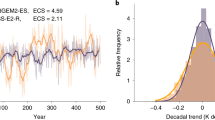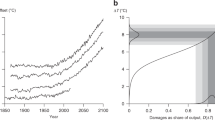Abstract
Equilibrium climate sensitivity (ECS) remains one of the most important unknowns in climate change science. ECS is defined as the global mean warming that would occur if the atmospheric carbon dioxide (CO2) concentration were instantly doubled and the climate were then brought to equilibrium with that new level of CO2. Despite its rather idealized definition, ECS has continuing relevance for international climate change agreements, which are often framed in terms of stabilization of global warming relative to the pre-industrial climate. However, the ‘likely’ range of ECS as stated by the Intergovernmental Panel on Climate Change (IPCC) has remained at 1.5–4.5 degrees Celsius for more than 25 years1. The possibility of a value of ECS towards the upper end of this range reduces the feasibility of avoiding 2 degrees Celsius of global warming, as required by the Paris Agreement. Here we present a new emergent constraint on ECS that yields a central estimate of 2.8 degrees Celsius with 66 per cent confidence limits (equivalent to the IPCC ‘likely’ range) of 2.2–3.4 degrees Celsius. Our approach is to focus on the variability of temperature about long-term historical warming, rather than on the warming trend itself. We use an ensemble of climate models to define an emergent relationship2 between ECS and a theoretically informed metric of global temperature variability. This metric of variability can also be calculated from observational records of global warming3, which enables tighter constraints to be placed on ECS, reducing the probability of ECS being less than 1.5 degrees Celsius to less than 3 per cent, and the probability of ECS exceeding 4.5 degrees Celsius to less than 1 per cent.
This is a preview of subscription content, access via your institution
Access options
Access Nature and 54 other Nature Portfolio journals
Get Nature+, our best-value online-access subscription
$29.99 / 30 days
cancel any time
Subscribe to this journal
Receive 51 print issues and online access
$199.00 per year
only $3.90 per issue
Buy this article
- Purchase on Springer Link
- Instant access to full article PDF
Prices may be subject to local taxes which are calculated during checkout




Similar content being viewed by others
References
Collins, M. et al. Long-term climate change: projections, commitments and irreversibility. In Climate Change 2013: The Physical Science Basis. Contribution of Working Group I to the Fifth Assessment Report of the Intergovernmental Panel on Climate Change (eds Stocker, T. F. et al.) Ch. 12 (Cambridge Univ. Press, 2013)
Hall, A. & Qu, X. Using the current seasonal cycle to constrain snow albedo feedback in future climate change. Geophys. Res. Lett. 33, L03502 (2006)
Morice, C. P. et al. Quantifying uncertainties in global and regional temperature change using an ensemble of observational estimates: the HadCRUT4 dataset. J. Geophys. Res. 117, D08101 (2012)
Knutti, R. et al. Beyond equilibrium climate sensitivity. Nat. Geosci. 10, 727–736 (2017)
Gregory, J. M. et al. An observationally based estimate of the climate sensitivity. J. Clim. 15, 3117–3121 (2002)
Forster, P. M. et al. Evaluating adjusted forcing and model spread for historical and future scenarios in the CMIP5 generation of climate models. J. Geophys. Res. Atmos. 118, (2013)
Gregory, J. M. & Andrews, T. Variation in climate sensitivity and feedback parameters during the historical period. Geophys. Res. Lett. 43, 3911–3920 (2016)
Forster, P. M. Inference of climate sensitivity from analysis of Earth’s radiation budget. Ann. Rev. Earth Planet. Sci. 44, 85–106 (2016)
Armour, K. C. Energy budget constraints on climate sensitivity in light of inconstant climate feedbacks. Nat. Clim. Chang. 7, 331–335 (2017)
Annan, J. D. & Hargreaves, J. C. Using multiple observationally-based constraints to estimate climate sensitivity. Geophys. Res. Lett. 33, L06704 (2006)
Cox, P. M. et al. Sensitivity of tropical carbon to climate change constrained by carbon dioxide variability. Nature 494, 341–344 (2013)
Wenzel, S. et al. Projected land photosynthesis constrained by changes in the seasonal cycle of atmospheric CO2 . Nature 538, 499–501 (2016)
Hasselmann, K. Stochastic climate models. I. Theory. Tellus 28, 473–485 (1976)
MacMynowski, D. G. et al. The frequency response of temperature and precipitation in a climate model. Geophys. Res. Lett. 38, L16711 (2011)
Caldeira, K. & Myhrvold, N. P. Projections of the pace of warming following an abrupt increase in atmospheric carbon dioxide concentration. Environ. Res. Lett. 8, 034039 (2013)
Geoffroy, O. et al. Transient climate response in a two-layer energy-balance model. Part I: Analytical solution and parameter calibration using CMIP5 AOGCM experiments. J. Clim. 26, 1841–1857 (2013)
Flato, G. et al. Evaluation of climate models. In Climate Change 2013: The Physical Science Basis. Contribution of Working Group I to the Fifth Assessment Report of the Intergovernmental Panel on Climate Change (eds Stocker, T. F. et al.) Ch. 9 (Cambridge Univ. Press, 2013)
Leith, C. E. Climate response and fluctuation dissipation. J. Atmos. Sci. 32, 2022–2026 (1975)
Taylor, K. E., Stouffer, R. J. & Meehl, G. A. An overview of CMIP5 and the experiment design. Bull. Am. Meteorol. Soc. 93, 485–498 (2012)
Andrews, T. et al. Forcing, feedbacks and climate sensitivity in CMIP5 coupled atmosphere-ocean models. Geophys. Res. Lett. 39, L09712 (2012)
Kiehl, J. T. Twentieth century climate model response and climate sensitivity. Geophys. Res. Lett. 34, L22710 (2007)
Lenton, T. M. et al. Tipping elements in the Earth’s climate system. Proc. Natl Acad. Sci. USA 105, 1786–1793 (2008)
Scheffer, M. et al. Early-warning signals for critical transitions. Nature 461, 53–59 (2009)
Otto, A. et al. Energy budget constraints on climate response. Nat. Geosci. 6, 415–416 (2013)
Lewis, N. & Curry, J. A. The implications for climate sensitivity of AR5 forcing and heat uptake estimates. Clim. Dyn. 45, 1009–1023 (2015)
Marvel, K. et al. Implications for climate sensitivity from the response to individual forcings. Nat. Clim. Chang. 6, 386–389 (2015)
Sherwood, S. C., Bony, S. & Dufresne, J.-L. Spread in model climate sensitivity traced to atmospheric convective mixing. Nature 505, 37–42 (2014)
Cowtan, K. & Way, R. G. Coverage bias in the HadCRUT4 temperature series and its impact on recent temperature trends. Q. J. R. Meteorol. Soc. 140, 1935–1944 (2014)
Acknowledgements
This work was supported by the European Research Council (ERC) ECCLES project, grant agreement number 742472 (P.M.C.); the EU Horizon 2020 Research Programme CRESCENDO project, grant agreement number 641816 (P.M.C. and M.S.W.); the EPSRC-funded ReCoVER project (M.S.W.); and the NERC CEH National Capability fund (C.H.). We also acknowledge the World Climate Research Programme’s Working Group on Coupled Modelling, which is responsible for CMIP, and we thank the climate modelling groups (listed in Extended Data Table 1 of this paper) for producing and making available their model output.
Author information
Authors and Affiliations
Contributions
All authors collaboratively designed the study and contributed to the manuscript. P.M.C. led the study and drafted the manuscript. C.H. was the lead on the time-series data for the CMIP5 models. M.S.W. led on the theoretical analysis.
Corresponding author
Ethics declarations
Competing interests
The authors declare no competing financial interests.
Additional information
Reviewer Information Nature thanks P. Forster and T. Mauritsen for their contribution to the peer review of this work.
Publisher's note: Springer Nature remains neutral with regard to jurisdictional claims in published maps and institutional affiliations.
Extended data figures and tables
Extended Data Figure 1 Test of emergent relationship against models not used in the calibration.
The test set includes additional models from some climate centres (labelled ‘f x’, ‘f y’ and so on), and initial condition ensembles with particular models (labelled ‘c2’, ‘c3’ and so on). The black dot-dashed line shows the best-fit linear regression across the model ensemble, with the prediction error for the fit given by the black dashed lines (see Methods). The vertical blue lines show the observational constraint from the HadCRUT4 observations: the mean (dot-dashed line) and the mean plus and minus one standard deviation (dashed lines). Individual CMIP5 model runs are denoted by the letters listed in Extended Data Table 1.
Extended Data Figure 2 Comparison of Ψ statistics for the 16 CMIP5 models from ‘filtered-mean’ temperature and global-mean temperature.
The filtered model output calculates area-mean values of temperature using only the points where there are observations in the HadCRUT4 dataset. All cases analyse 1880–2016 and use a 55-yr window width. The dotted line is the 1:1 line.
Extended Data Figure 3 Gradient of emergent relationship between ECS and Ψ as a function of window width.
The dotted line shows the gradient predicted with equation (2) using the ensemble-mean value of Q2×CO2/σN. Note that the theory (dot-dashed line) fits best at the optimal window width of 55 yr. All cases here analyse 1880–2016 and use the 16-model ensemble.
Rights and permissions
About this article
Cite this article
Cox, P., Huntingford, C. & Williamson, M. Emergent constraint on equilibrium climate sensitivity from global temperature variability. Nature 553, 319–322 (2018). https://doi.org/10.1038/nature25450
Received:
Accepted:
Published:
Issue Date:
DOI: https://doi.org/10.1038/nature25450
This article is cited by
-
Emergent constraints on carbon budgets as a function of global warming
Nature Communications (2024)
-
Energy transition under scenario uncertainty: a mean-field game of stopping with common noise
Mathematics and Financial Economics (2024)
-
A systematic review of regional and global climate extremes in CMIP6 models under shared socio-economic pathways
Theoretical and Applied Climatology (2024)
-
A frequent ice-free Arctic is likely to occur before the mid-21st century
npj Climate and Atmospheric Science (2023)
-
Constrained tropical land temperature-precipitation sensitivity reveals decreasing evapotranspiration and faster vegetation greening in CMIP6 projections
npj Climate and Atmospheric Science (2023)
Comments
By submitting a comment you agree to abide by our Terms and Community Guidelines. If you find something abusive or that does not comply with our terms or guidelines please flag it as inappropriate.



